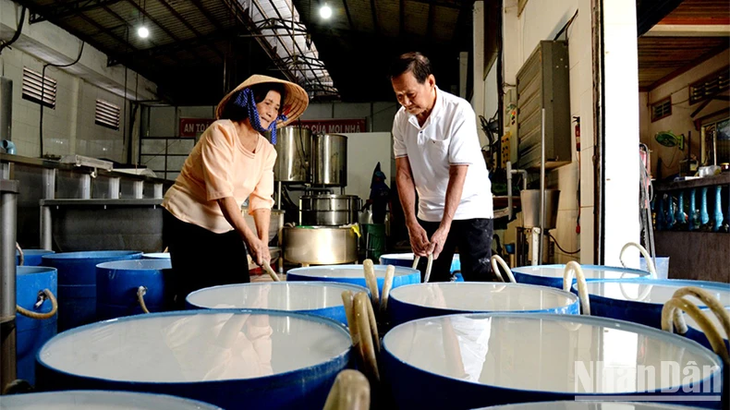Sa Dec city in Dong Thap province is famous as the flower capital of the southwestern region and for its 100-year-old craft of making rice flour. A year-round source of fresh water and suitable terrain and climate have contributed to the superior quality of Sa Dec rice flour.

Sa Dec municipal leaders receive the certificate recognizing Sa Dec rice flour making as the National Intangible Cultural Heritage of traditional handicrafts and folk knowledge. (Photo: VNA)
In the 18th century, people migrated from the North and Central regions to the South and settled in the fertile land of Sa Dec. They needed to store food for the rainy season and found ways to keep food for a long time, such as converting rice grains to flour.
By the end of the 19th century and the beginning of the 20th century, Tan Phu Dong village had become famous for making rice flour and flour products. Sa Dec rice flour is known for its whiteness, smoothness, softness, and characteristic aroma.
Favored by nature, Sa Dec stands between the Tien and Hau rivers. The stretch of the Tien River flowing past Sa Dec has a neutral pH, not acidic from alum nor brackish due to salinity. This fresh river water and the Mekong Delta’s rice variety have made the Sa Dec rice flour brand.
Nguyen Van Nuong, owner of the Tu Nuong flour production facility and chairman of the Sa Dec Flour Village Club, says his family has been engaged in the craft for more than 100 years. Now he continues to preserve and develop the craft.
He told VOV, “My children and I are determined to preserve and promote the traditional craft that our predecessors handed down. Everyone in the club takes responsibility for developing the flour-making craft while ensuring food safety and environmental protection.”
The craft provides a stable income for Tu Nuong's family and other households in Sa Dec. Many have savings. When they made flour manually it required lot of time, effort, and many steps. Now the villagers have invested in machinery – washing machine, grinding machine, powder pressing frame, sedimentation tank, pumping system, and by-product suction system. This has reduced the labor required, lowered production costs, and improved hygiene, purity, and quality.

Tools used to make Sa Dec rice flour (Photo: VNA)
Sa Dec has 160 households producing flour, employs 1,000 workers, and outputs 30,000 tons of flour a year. Many products including brown rice flour with lotus seed and barley, coconut pancake flour, rice noodle soup, and dry noodle soup, have met the 4-star OCOP standards.
Last month the Ministry of Culture, Sports and Tourism added the Sa Dec rice flour craft to the National Intangible Cultural Heritage list of traditional handicrafts and folk knowledge. Vo Thi Binh, Deputy Chairwoman of the Sa Dec municipal People’s Committee, said that the Sa Dec administration will promote the village craft as an intangible cultural heritage.
“The village will become known as a traditional but innovative craft village that applies technology to production. The administration and the residents will cooperate in making the craft thrive,” said Binh.

A workshop of rice flour making in ward 2 in Sa Dec city (Photo: Kim Ngan)
Pursuant to the Sa Dec Flour Craft Village Development Project until 2020 with a vision to 2030, the village will link production, distribution, and community tourism, and combine the flour-making village with Sa Dec flower village. The combination of the two villages will attract tourists, introduce the locality’s unique culture, and boost local economic development.
For 100 years the flour-making craft has continued to grow in scale and production methods. Family secrets and traditional techniques plus the application of new technology have ensured the longevity of Sa Dec rice flour making.